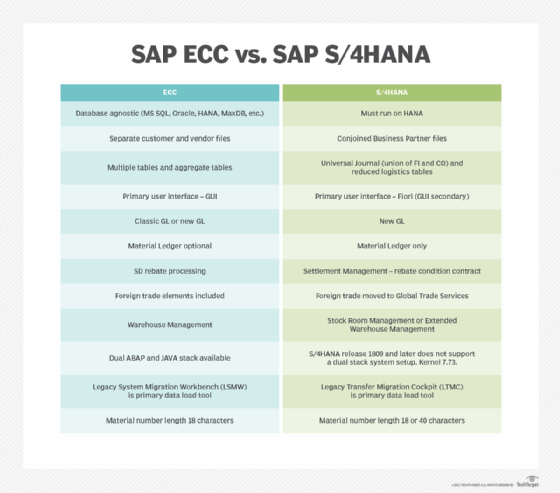
kentoh - Fotolia
Compare SAP S/4HANA vs. SAP ECC: Five main differences
As ECC users consider their options for the future, understanding how their current SAP ERP system compares to S/4HANA is critical. Here are some important differences.
Foundational change can be an intimidating business prospect, particularly when it comes to aging SAP ERP software. Staying put may seem like the safest course of action.
Many business and IT leaders find themselves in a state of analysis paralysis as 2027 approaches -- and with it, the end of SAP's maintenance support for its legacy SAP ERP Central Component (ECC) software. Many are asking themselves: What would a move to SAP S/4HANA take? When is the right time to do it? How should we best execute it?
The process begins with an embrace of SAP's intelligent enterprise framework -- an all-encompassing shift in the organization's processes toward the digitally transformed future. This requires the combination of modern technologies with defined, resilient and sustainable integrated business processes. It requires bringing operational and experiential data together. It also requires factoring customer experience and employee experience into every evaluation. It means bringing analytics to the forefront of the decision-making process.
However, to successfully embody this digitally enabled future, companies must plan ahead today by expanding their capabilities, embracing technology with unparalleled functionality and capitalizing on the opportunity S/4HANA provides. What must they do to make that happen? Here's a closer look at some differences between SAP ECC and S/4HANA. Such comparisons can help point the way forward and highlight the opportunities available.
Similarities
The two SAP ERP systems share a number of commonalities.
Both ECC and S/4HANA enable business operations for sales, procurement, manufacturing, distribution, service, quality, accounting operations and plant maintenance. Both systems offer centralization of a company's operational information in a single database; standardization and automation of routine tasks and a single source for operational reporting. ECC and S/4HANA are both modular systems, designed so businesses can use the pieces they need, configured in a way that makes sense for their business requirements.
All in all, SAP S/4HANA and SAP ECC probably share 90% of their core features and functions. However, with technological shifts, there are bound to be differences and benefits companies can reap within them.

Differences
The above chart shows several of the key differences between SAP ECC and SAP S/4HANA. Let's dive a little deeper by spotlighting the five biggest differences below.
- Database. SAP ECC can run on third-party databases like Oracle, MaxDB and IBM. SAP S/4HANA can only run on SAP HANA, an in-memory modern technology.
- Customer vs. vendor to Business Partner. SAP ECC maintains separate customer and vendor files, even in those cases where an organization partners with a company for both functions. S/4HANA combines common data structure elements into a Business Partner record.
- Merger of Controlling (CO) and Finance (FI). In SAP ECC, FI GL accounts are mapped to CO primary cost elements. In S/4HANA, the structure of the universal journal is used to store both GL account and cost element.
- New General Ledger (GL). SAP ECC can run on either a "classic" GL structure or the "new" GL structure. S/4HANA uses only the new GL, which is technically very similar to that of the new GL in ECC. However, the new GL's functionality is required in S/4HANA and is a prerequisite for new asset accounting.
- Rebates. Customer rebates through existing SD rebate processing in ECC have been replaced by settlement management through condition contracts in S/4HANA.
The next generation of SAP ERP
To be sure, there are deltas on both sides of the Venn diagram when it comes to S/4HANA and ECC. However, like a great chess player, successful leaders must look several moves ahead to ensure they stay on the right path on their business roadmap.
SAP ECC can help the business run today. But to get where the business needs to go tomorrow, the infrastructure provided by SAP S/4HANA provides a foot in the door of the SAP intelligent enterprise. The real power of the move to S/4HANA isn't in the ERP differences today; it's in the business differences tomorrow.
About the author:
Brad Hiquet is an accomplished ERP strategist and SAP integration architect. He is vice president of client engagement at Dickinson + Associates, where he is responsible for the company's S/4HANA Movement program.






